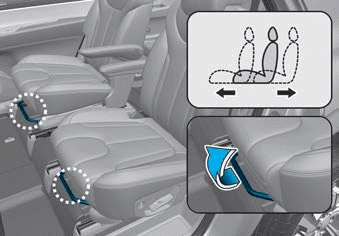Hyundai Palisade: Cruise Control System / Schematic diagrams
Hyundai Palisade (LX2) 2020-2025 Service Manual / Engine Electrical System / Cruise Control System / Schematic diagrams
| System Block Diagram |

Component Parts And Function Outline
|
Component part |
Function |
|
|
Vehicle-speed sensor, ESP/ABS Control Module |
Converts vehicle speed to pulse. |
|
|
ECM |
Receives signals from sensor and control switches. |
|
|
Cruise control indicator |
Illuminate when CRUISE main switch is ON (Built into cluster) |
|
|
Cruise Control switches |
CRUISE switch |
Switch for automatic speed control power supply. |
|
RES+ switch |
Controls automatic speed control functions by Resume/Accel switch (Set/Coast
switch) |
|
|
SET- switch |
||
|
Cancel switches |
Cancel switch |
Sends cancel signals to ECM. |
|
Brake-pedal switch |
||
|
Transaxle range switch (A/T) |
||
|
ETC motor |
Regulates the throttle valve to the set opening by ECM. |
|
* ETC Motor : Electronic Throttle Control Motor
 Description and operation
Description and operation
Cruise Control
The cruise control system is engaged by the cruise "ON/OFF" main switch located
on the right-hand side of steering wheel column...
 Troubleshooting
Troubleshooting
Trouble Symptom Charts
Trouble Symptom 1
Trouble Symptom 2
Trouble symptom
Probable cause
Remedy
The set vehicle speed varies greatly upward or downward
"Surging" (repeated alternating acceleration and deceleration) occurs after
setting
Malfunction of the vehicle speed sensor circuit
Repair the vehicle speed sensor system, or replace the part
Malfunction of ECM
Check input and output signals at ECM
Trouble Symptom 3
Trouble symptom
Probable cause
Remedy
The CC system is not canceled when the brake pedal is depressed
Damaged or disconnected wiring of the brake pedal switch
Repair the harness or replace the brake pedal switch
Malfunction of the ECM signals
Check input and output signals at ECM
Trouble Symptom 4
Trouble symptom
Probable cause
Remedy
The CC system is not canceled when the shift lever is moved to the "N" position
(It is canceled, however, when the brake pedal is depressed)
Damaged or disconnected wiring of inhibitor switch input circuit
Repair the harness or repair or replace the inhibitor switch
Improper adjustment of inhibitor switch
Malfunction of the ECM signals
Check input and output signals at ECM
Trouble Symptom 5
Trouble symptom
Probable cause
Remedy
Cannot decelerate (coast) by using the "SET/–" switch
Temporary damaged or disconnected wiring of "SET/–" switch input circuit
Repair the harness or replace the "SET/–" switch
Malfunction of the ECM signals
Check input and output signals at ECM
Trouble Symptom 6
Trouble symptom
Probable cause
Remedy
Cannot accelerate or resume speed by using the "RES/+" switch
Damaged or disconnected wiring, or short circuit, or "RES/+" switch input
circuit
Repair the harness or replace the "RES/+" switch
Malfunction of the ECM signals
Check input and output signals at ECM
Trouble Symptom 7
Trouble symptom
Probable cause
Remedy
CC system can be set while driving at a vehicle speed of less than 40km/h
(25mph), or there is no automatic cancellation at that speed
Malfunction of the vehicle-speed sensor circuit
Repair the vehicle speed sensor system, or replace the part
Malfunction of the ECM signals
Check input and output signals at ECM
Trouble Symptom 8
Trouble symptom
Probable cause
Remedy
The cruise main switch indicator lamp does not illuminate (although CC system
is normal)
Damaged or disconnected bulb of cruise main switch indicator lamp
Repair the harness or replace the part...
Other information:
Hyundai Palisade (LX2) 2020-2025 Service Manual: Repair procedures
Adjustment TCM Learning 1. Overview and purpose of learning 1) The purpose is to ensure the initial operation safety by correcting the oil pressure differences between transmissions...
Hyundai Palisade (LX2) 2020-2025 Service Manual: 3rd Seat Folding System
Components and components location Components 3rd Seat 1. 3rd right folding motor 2. Folding seat control unit 3. 3rd left folding motor Luggage Side Trim 1. 2nd/3rd integrated seat switch (3rd Folding/Unfolding) 2...
Categories
- Manuals Home
- 1st Generation Palisade Owners Manual
- 1st Generation Palisade Service Manual
- Electrochromatic Mirror (ECM) with homelink system
- Electronic Child Safety Lock System
- AWD Operation
- New on site
- Most important about car
Rear Seats
Rear seat adjustment

Forward and rearward (2nd row seat)
To move the seat forward or rearward:
1. Pull the seat slide adjustment lever up and hold it.
2. Slide the seat to the position you desire.
Copyright © 2025 www.hpalisadelx.com
